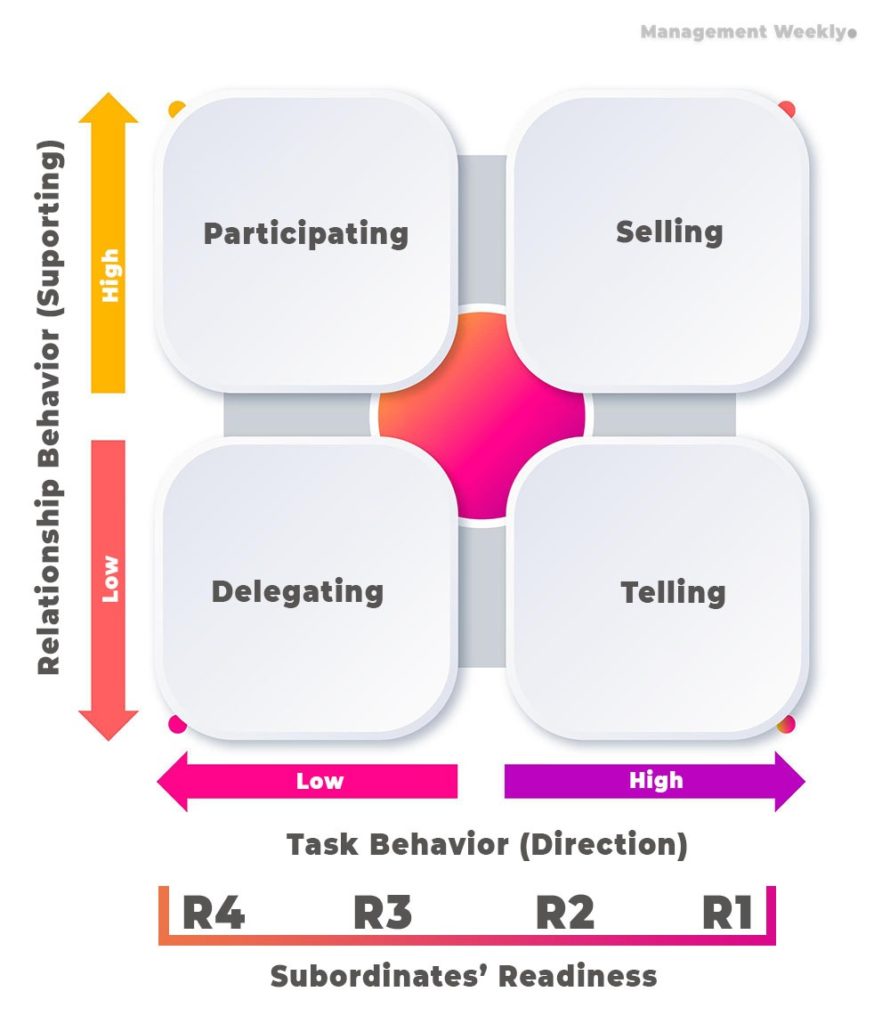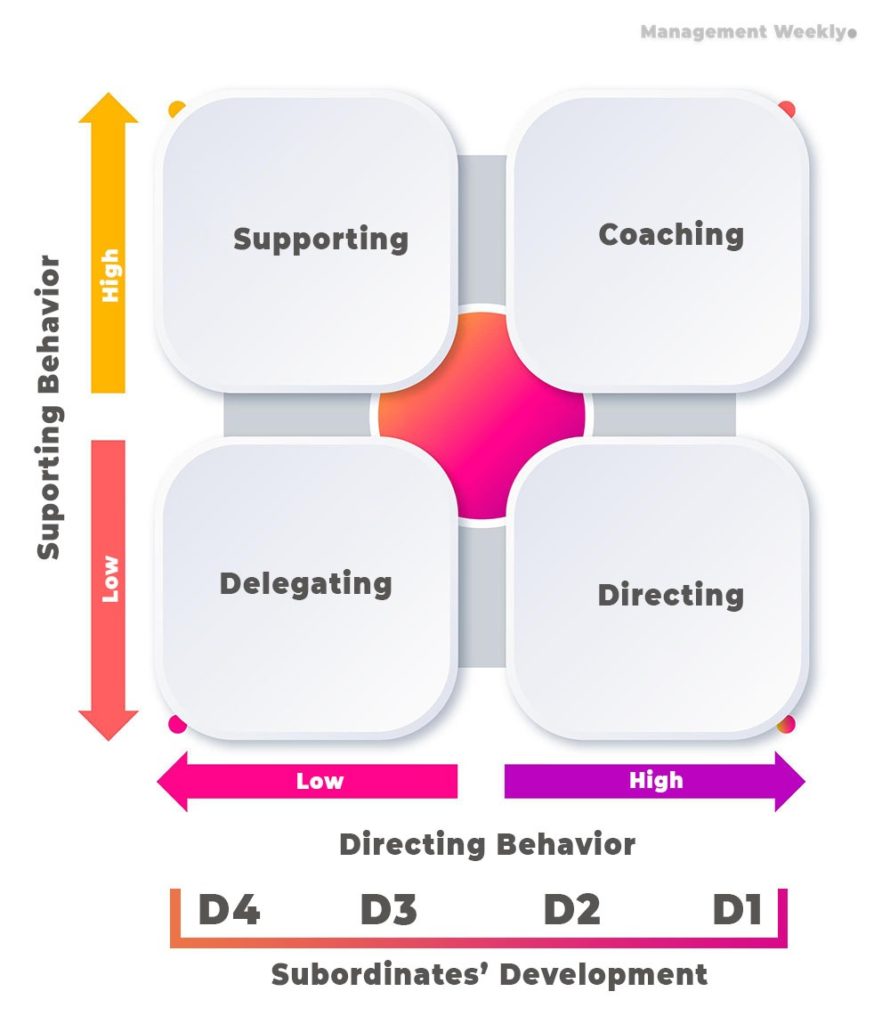Situational Leadership Model: Hersey and Blanchard

Hersey and Blanchard developed the Life Cycle Theory of leadership, which later came to be known as the Situational Leadership Model. They borrowed from the dimensions of initiating structure and consideration to formulate the situational leadership model. Their basic argument is that the primary determinant of leader behavior is two factors of subordinate behavior:
- Job Maturity (later termed Task Development)
- Psychological Maturity (later termed Psychological Development)
The subordinate performance was proposed to be ability times motivation. In other words, it is a combination of task development and psychological development.
It is also crucial to note that Hersey and Blanchard developed some differences in 1977. After that Blanchard preferred to call his model Situational Theory of Leadership II. However, experts claim that the differences between the two models are only superficial. For instance, Hersey preferred to use the term “Readiness” whereas Blanchard preferred to call it “Development”.

Subordinates’ Behavior
Since the situational model of leadership places primary importance on subordinate behavior, we will discuss the two important factors of subordinate behavior first.
Task Development
Task development refers to the capacity or ability of the subordinate to perform the job. It depends upon the level of education and the amount of experience the individual has. Blanchard called this dimension development because he believed that this dimension develops over time. Hersey preferred to call this task readiness.
Psychological Development
Psychological development refers to the motivational state of the subordinate. Self-esteem and confidence are key components of this dimension. This dimension also includes the component of achievement-orientation. In other words, more the subordinate desires to achieve, greater is the psychological development. Blanchard preferred to use the term commitment whereas Hersey called it willingness.
4 Types of Subordinate Behavior
Based on the level of task development and psychological development, there may be 4 types of subordinate behavior.
Unable and Unwilling
As the name suggests, this type of subordinates are the toughest to deal with. This is because they neither have the skill set required to perform the task nor do they have the motivation to do so. They have low competence and low motivation. Hersey labelled this type of subordinates as R1 (Readiness 1) whereas Blanchard labelled them as D2 (Development 2).
Unable and Willing
Hersey termed this category of subordinates as R2 (Readiness 2). However, Blanchard called them D1 (Development 1). This is because, according to Blanchard, new employees exhibit this combination. Although they are very motivated and willing to learn the task and achieve quick success, they have very low levels of on-the-job experience. They require a high amount of supervision to learn the task.
Able and Unwilling
In Hersey’s vocabulary, this stage is R3 and in Blanchard’s terminology this stage is D3. Subordinates in this stage have gained some experience and skill set required for performing the task. However, they may become unwilling or demotivated as the task becomes more and more complex. In addition, Blanchard claims that in this stage, some subordinates may become disillusioned after their initial spurt of energy and effort. Subordinates require some hand-holding in this stage so that they can develop the required self-esteem and confidence.

Able and Willing
This is the final stage of readiness (R4) and development (D4). Subordinates in this stage have not only learned the task but are also confident and ready to take responsibility for the same. Hence, they can work independently and require very little or no supervision.

Leader’s Behavior
Based on the subordinates’ stage of readiness or development, leaders’ style of leadership may be directive or supportive.
Directive Leadership Style
A leader whose leadership style falls on the directive end of the spectrum has high concern for production. They do not focus much on development of the subordinates. Rather they are interested in maximizing production by directing the subordinates.
Supportive Leadership Style
In this style of leadership, the leader supports subordinates because he has high concern for people. The leader is interested in building personal relationships with the subordinates and is concerned about their development and well-being. Depending on the readiness or development stage of the subordinate, such leaders modify their leadership style.
Telling or Directing
This style of leadership is most suitable for subordinates who are in R1 and D1 stages of readiness and development, respectively. Directing behavior is high and supporting behavior is low in this stage. Subordinates know very little about the task or they have very low levels of motivation to perform well. As a result, they need close supervision and guidance. Subordinates need high levels of hand-holding in this stage. The leader usually breaks the task down into smaller bits so that it is easier for the subordinates to grasp the task and learn the skill slowly. Blanchard maintains that this form of leadership is useful in leading new employees who have very high motivation but low expertise. Hersey claims that it is also useful for those who have low motivation.
Selling or Coaching
This style is a combination of high supportive and high directive behavior. Hersey claims that this style of leadership is useful in leading subordinates who are in R2. This is because such subordinates are willing but are not being able to perform for some reason. The main responsibility of the leader is to guide the subordinates in such a way that they are able to develop the requisite confidence and skill set for performing the task independently. Blanchard, on the other hand, maintains that this style is suited for subordinates who have learned some of the skills for the job but are unwilling (D2) as they have lost motivation. Specifically, he calls this group of subordinates disillusioned learners as they are exhausted by the gradual increase in task complexity and responsibility.
Participating and Supporting
In this style of leadership, supporting is high but direction is low. It is suited for both R3 and D3 subordinates. Leaders need to interact with the subordinates and listen to their ideas and opinions. Since the subordinate has learned for a long time, leaders in this stage trust that they are capable of accomplishing day-to-day tasks independently. In sum, this leadership style involves gradually increasing the level of independence of the subordinates.
This style of leadership consists of low support and low direction. It is useful for subordinates in stages R4 and D4. Since the subordinates have already acquired skills and competence and willingness, leaders do not need to provide too much guidance. Rather the subordinates are ready to take on responsibilities and perform complex tasks. The leaders’ role is to provide support as and when required.

Hersey’s and Blanchard’s theory of situational leadership is of much use to leaders all over the world. It provides a one step solution to leaders regarding how much they should support and direct their subordinates. They just need to be aware of the readiness or developmental level of their employees.
Sharing is caring!
Leave a Comment Cancel reply
Save my name, email, and website in this browser for the next time I comment.

IMAGES
VIDEO
COMMENTS
March 16, 2021 by Shayani Sengupta. Hersey and Blanchard developed the Life Cycle Theory of leadership, which later came to be known as the Situational Leadership Model. They borrowed from the dimensions of initiating structure and consideration to formulate the situational leadership model. Their basic argument is that the primary determinant ...